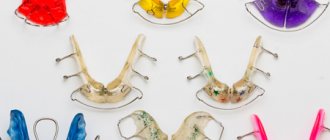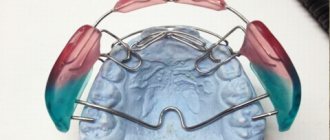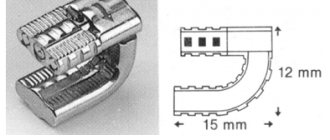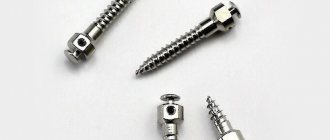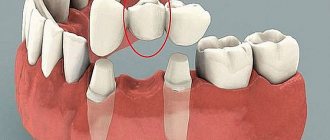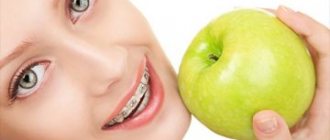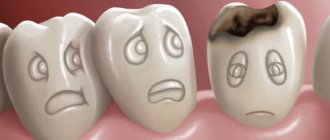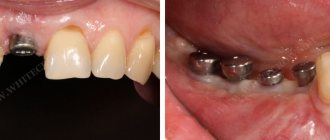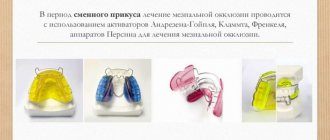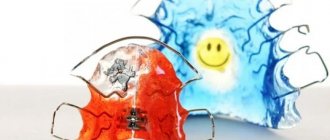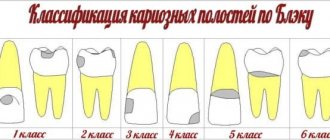Orthodontic devices are special designs that are used in modern dentistry to correct the bite. According to statistics, more than 80% of people have an incorrect bite. In mild cases, this does not cause any particular inconvenience, and does not even spoil the smile much. But if the defects are significant, then this causes discomfort, spoils the appearance, causes caries or tooth abrasion, diseases of the temporomandibular joint and other problems.
Adjustment
To adjust the apparatus, screws, arcs, ligatures, inclined and bite pads, and levers are used. The most common arcs perform the following tasks:
- creating a moving force;
- fixation, protection against movement or tilting;
- providing a barrier function, a boundary between the tissues of the cheek and the teeth;
- exclusion of movement in a certain direction.
The arc works according to different principles, which depends on its type and purpose. It can transmit force from the ligature and control the position of the device using locks. Also, the arch can directly affect a row or an individual tooth.
The loops are made of metal wire; they transmit force between the individual elements of the orthodontic structure. Levers and springs exert a force, a moving force. Such elements are used for body movement, simultaneously with anchorage implants.
Screws are used to correct misaligned teeth. The rotation of the screw allows the row units to be moved apart, providing precise linear movement in a given direction. the process is controlled by a doctor; if necessary, simultaneous displacement is performed in several directions.
Ligatures are also used for orthodontic appliances, providing flexible or rigid fixation. For mouthguards made of metal or plastic, bite and inclined platforms are installed that activate or inhibit growth in a certain direction.
General overview
From a technical point of view, the models under consideration are characterized by the impact on both the bite and the elements of the dentition, provided by force pressure arising from the design features. In this case, the masticatory muscles do not participate in the correction process. Active elements of mechanical orthodontic devices are used as a source of force, which include screws, inclined arches, spring and traction parts.
The degree of pressure exerted by the device is adjusted by the orthodontist, and requires compliance with the recommendations of the maximum permissible value, which cannot exceed the natural level of blood pressure in the capillaries - 20 g/sq. see. When the standard indicator is met, conditions are created that promote the safe displacement of teeth and reformation of the bone structure. Excessive applied force leads to compression of blood vessels and nerve receptors, provoking the development of negative consequences.
Time frame for bite correction
It is no secret that the average time to correct a bite is 1–3 years. Many patients stop noticing braces within a month after they are installed. It is important to understand that treatment is not limited to wearing the structure. After removing the braces, a period of wearing a retainer follows, which on average lasts 2 times longer than the previous stage of treatment.
The fact is that even wearing orthodontic devices (braces) for such a long time does not guarantee a change in the position of the teeth forever. The jaw muscles sooner or later return to their original position. Therefore, the installation of retainers is strictly necessary as a fixative measure after treatment with braces. A retainer is a special wire that is attached to the inside of the jaw in a non-removable version, or a transparent mouth guard in a removable version. It is necessary to wear removable aligners strictly according to the doctor’s recommendations, so as not to negate the results of long-term orthodontic treatment.
Why do patients choose vestibular plates? Advantages and disadvantages of designs
Pros of orthodontic plates:
- The price is within reason.
Low cost compared to the same braces (the cost of the design ranges from 8,000 to 10,500 rubles per course of treatment);
- Easy to wear and hygienic.
The patient can easily remove it from the mouth before eating, wash it, and put on the device independently.
- Eat what you like.
When wearing plates, there are no restrictions on food consumption. You can eat meat, hard and sticky foods. The design is simply removed before eating and put on afterwards. - Correction of the position by a doctor or independently.
During dental treatment, you can always adjust the tension force. This can be done by the patient himself, tightening the lock, or by the dentist during a follow-up visit.
- Optimal aesthetics.
People around see only a metal arc on the teeth, and with close contact, the interlocutor practically does not notice the plate.
The nuances of using orthodontic plates for teeth:
- Wear for about 2 years.
The estimated duration of treatment is 20 months or more, depending on the pathology of the bite. In any case, the treatment is worth it so that after about two years the teeth are straight and healthy.
- Some discomfort for the patient.
It is felt immediately after installing the device on the teeth or after tightening it, but patients quickly get used to this position.
- It is impossible to correct serious pathologies.
Unfortunately, vestibular plates are not able to correct serious pathologies of the bite and teeth. In this case, orthodontists recommend treatment with braces.
- It all depends on the patient's motivation.
This is especially true for children who do not always strictly follow doctors’ recommendations for regularly wearing plates. In addition, the plate must be worn on the teeth for 20–22 hours, and not every child agrees to follow this iron rule.
Fixing elements of orthodontic devices
Golovko Nonna Vasilievna , Associate Professor of the Department of Propaedeutics, Orthopedic Dentistry and Orthodontics of the Ukrainian Medical Dental Academy.
Fixation is the strengthening of the orthodontic apparatus or denture on the jaw in static conditions, and stabilization is the stability of the orthodontic apparatus or denture during functions (speech, chewing, swallowing).
One of the most common methods of fixing removable orthodontic appliances and dentures is the use of fixing devices, which include:
- Clasps.
- Crowns or rings.
- Mouthguards.
- Combined fixation according to M.A. Napadov (dentoalveolar or dentogingival).
A clasp (from German – klammer – hook) is a special device that is designed for attaching the base of a removable orthodontic appliance or denture to the teeth.
Clasps are classified as follows:
I. By location: dental, gingival (pelota), dentogingival;
- Clasps using the subequator tooth space: - single-arm round bent clasp,
- - Jackson flip clasp,
- - Duisings clasp,
- - Adams clasp,
- - frame clasp,
- - tape clasp.
- - Schwartz arrow-shaped clasp,
II. According to the nature of contact between the clasp arm and the tooth crown:
- Group 1 – clasps with a plane contact of the shoulder to the tooth crown (bent and cast tape clasps). Clasps of this group have a large surface of contact with the crown of the tooth and sometimes lead to abrasion of the enamel and make it difficult for the teeth to self-clean from food debris, which can lead to the development of caries. They are also imperfect from an aesthetic point of view. The fixing effect is achieved by increasing the plane of contact of the clasp arm to the tooth and the force of its pressing. However, the latter increases the load on the supporting tooth.
- Group 2 – clasps with a linear contact of the shoulder to the tooth crown. This group consists of the following clasps: round single-arm bent clasp, Jackson flip clasp, Duisings clasp, frame clasp and others. Such clasps have sufficient elasticity because they are bent from round elastic orthodontic wire. The improvement in the fixing effect in the Jackson reversible clasp and the Duisings clasp in comparison with the round single-arm bent one is explained by the increase in the area of contact between the shoulder and the body of the clasp to the tooth. They are less noticeable to others.
- Group 3 – clasps with a point contact to the tooth crown. This group consists of the following clasps: button, spear-shaped, hook-shaped, arrow-shaped Schwartz and Adams clasp. They have greater elasticity because they are bent from thinner orthodontic wire. These clasp designs optimally solve basic problems and provide fixation of removable orthodontic appliances and dentures. They are hardly noticeable.
In comparison with clasps of groups 1 and 2, clasps of group 3 minimally injure the tooth enamel, since they contact the tooth surface pointwise, that is, over a small area.
III. Shape: (round, semicircular, flat or ribbon).
IV. By manufacturing method: (bent and cast).
V. According to the degree of coverage of a tooth or several teeth: (single-armed, double-armed, ring-shaped or reversible, double and multi-linked).
VI. By function: (retaining and support-retaining). Retaining clasps are intended exclusively for fixing removable orthodontic appliances and dentures. With these types of clasp fixation, the vertical chewing load is completely transmitted through the base to the mucous membrane. Support-retaining clasps of clasp dentures and orthodontic clasp appliances not only fix, but also make it possible to distribute the chewing load between the mucous membrane of the prosthetic bed and the periodontium of the supporting teeth.
VII. According to the material from which the clasps are made: steel, gold, plastic.
VIII. According to the method of connection with the base or in relation to the body and shoulder of the clasp: rigid or stable, springy or semi-labile, articular or labile.
IX. Depending on the number of teeth used for fixation: point fixation - use of 1 single-arm clasp, linear - use of two single-arm clasps, planar - use of more than 3 single-arm clasps.
Retaining clasps, which are most widely used in orthodontic practice, consist of a shoulder, a body and a process.
The clasp arm is its elastic part, which covers the crown of the abutment tooth. Its location is determined by the anatomical shape of the tooth. In practical dentistry, it is customary to divide the surface of the tooth crown into 2 parts: occlusal and cervical. The boundary between them is the equator, that is, the line that runs along the most convex part of the tooth. The clasp arm provides fixation of a removable orthodontic appliance or denture. Crossing the belt of the supporting tooth, it is tightly pressed against the gingival part, which has the smallest diameter.
When making the arm of a retaining clasp, you must remember the following requirements:
- The shoulder should cover the tooth from the labial or buccal side, located directly behind the line of greatest convexity, that is, between the equator and the gum.
- The clasp arm, round or flat, should touch the tooth surface at as many points as possible. The fit at only one point leads to a sharp increase in pressure during movements of the base of the prosthesis or apparatus and leads to abrasion of the enamel.
- The shoulder should be elastic when the base shifts. Not all clasps have this quality. Wire clasps are the most elastic, cast ones are less flexible. Unlike bent wire clasps, cast clasps more accurately follow the relief of the tooth surface.
- The shoulder should be passive, that is, not transfer pressure to the supporting tooth.
- The shoulder must be rounded and polished to prevent injury to the buccal mucosa.
The clasp body is its stationary part, which is located above the equator of the abutment tooth on its contact side. It should not be placed below the equator (near the neck of the tooth), since in such cases the clasp interferes with the application of the prosthesis or orthodontic apparatus. On the front teeth, from an aesthetic point of view, this rule can be abandoned by placing the body of the clasp closer to the gingival margin.
The clasp extension is designed for attaching the clasp to the base of a prosthesis or orthodontic apparatus. It should be 0.5-0.7 mm away from the mucous membrane.
The clasps are placed in the orthodontic appliance or denture in such a way that they do not interfere with the rotation of the base.
Clasp fixation is called point fixation if it is located in one area (on one tooth). Fixation in which the clasps can be connected by a line is called linear. The location of the clasps at three or more points allows them to be combined along a plane, which is why such fixation is called planar. This type of fixation is more reliable. The reliability of fixation depends not only on the number of clasp points, but also on their relative position in relation to the midline of the alveolar arch. The conditional line that connects 2 clasps is called a clasp line. It can cross the midline of the alveolar process at an angle that is close to straight; cross it diagonally or run parallel to it on one or both sides. Thus, clasp lines can have a transversal, diagonal or sagittal direction.
To fix a removable orthodontic appliance or prosthesis on the lower jaw, it is advisable to place the clasps along the transversal, as they will counterbalance the lifting of the base by the muscles of the tongue and floor of the mouth.
To fix a removable orthodontic appliance or prosthesis on the upper jaw, it is better to use a diagonal arrangement of clasps, since the diagonal clasp line crosses the midline of the alveolar process and the fixing effect of the clasps extends to both halves of the prosthesis.
The choice of fixing elements depends on:
- presence of teeth and interdental contacts,
- group affiliation of the tooth,
- tooth crown height,
- expressiveness of the equator,
- presence (severity) of the vestibular subequatorial space,
- depth of the vestibule of the oral cavity,
- the presence of space between the upper and lower teeth in a state of central occlusion.
Single-arm round bent clasp:
It is the easiest to manufacture and ensures good stability of the apparatus if it is placed taking into account the direction of the acting forces and is manufactured in sufficient quantity. The choice of abutment teeth is associated with the location of the clasp lines.
Place a single-arm round curved clasp on the lateral teeth (2-3 on each side of the dentition). It is bent from orthodontic wire with a diameter of 0.6-0.8 mm (0.6 mm wire for temporary teeth, and 0.8 mm for permanent teeth). It covers the tooth in the subequatorial space. If it is made on the last distally located tooth, then it should not cross the interdental occlusal space.
A single-arm round bent clasp consists of a shoulder that covers the tooth from the vestibular side; body - the middle, or elastic part, which connects the clasp arm with the process and the process, which is welded into the base of the orthodontic apparatus or denture.
Such a clasp covers the tooth only on one side and performs only the function of holding. Since the clasp is firmly fixed in the base, its shoulder has a constant elastic action.
The clasp on the tooth is placed strictly in relation to the equator. On the teeth of the upper jaw, the clasp arm is located above the equator, on the teeth of the lower jaw - below, which ensures that the arm slides along the convexity of the tooth crown when fixing the apparatus. The height of the clasp should be determined taking into account the closure of the dentition so that it does not interfere with the movements of the lower jaw. The larger the elastic part of the clasp, the more elastic it is and the less harmful the effect it has on the supporting tooth.
A single-arm round bent clasp can be made elongated and cover the tooth located in front. But this does not lead to a significant improvement in the retention effect.
If it is necessary to use both a plate apparatus and rings on molars with locks and tubes to fix extraoral traction, a single-arm clasp is located under the lock and tube.
If there are defects in the dentition, it is possible to manufacture a round, double-armed clasp, in which one arm covers the tooth from the vestibular surface, and the other from the oral surface. Both shoulders are united using a body, which is placed in the area of the defect. It is advisable to use such a clasp design in the manufacture of removable orthodontic appliances, which also perform the function of replacing dentition defects.
Such a clasp can be bent from one piece of wire with a diameter of 0.6 mm or made up of two single-arm clasps.
Ear-shaped clasp - also bent according to the principle of making a single-arm round bent clasp, but at the end of the shoulder there is a curve in the form of an auricle. The ear-shaped clasp can be made multi-link.
The Jackson flip-over clasp has two bodies and two branches. This type of clasp is called combined due to the creation of elements of resistance and the transfer of pressure to the crowns of the teeth. To make a clasp, orthodontic wire with a diameter of 0.8-1.0 mm is used.
The Duisings clasp (Fig. 17) has 2 semicircular bends on the shoulder, which enhances its elasticity, elastic properties and fixation. For its manufacture, orthodontic wire with a diameter of 0.5-0.6 mm is used.
A necessary condition for using the Duisings clasp is a sufficient height of the crowns of permanent teeth.
Rice. 17. Duisings clasp.
The frame clasp differs from the designs described above in that its shoulder covers a group of teeth. The retaining part – the frame – is placed on the vestibular surface of the lateral teeth. It presses the teeth against the base of the apparatus and does not slide on the latter, since the equator of the supporting teeth prevents this. The part of the frame that is located in the area of the alveolar process should lag behind the mucous membrane by 0.5 mm and not reach the transitional fold.
Frame clasps are indicated during the period of teeth change. The loss of a temporary tooth does not weaken the fixation of the device, since the clasp rests on several teeth. Frame clasps are convenient in cases where the equator of primary teeth is well defined.
Tape clasps are rarely used in the manufacture of orthodontic structures, mainly for retention of the location of anterior teeth after their rotation around an axis or mesio-distal movement. In the latter case, the clasp on the vestibular surface of the tooth is shortened and left in the form of a barely noticeable paw. To make a tape clasp, use a flat steel tape 1.5-2 mm wide and 0.3-0.4 mm thick. It can also be made from round orthodontic wire with a diameter of 0.9-1.0 mm, if it is flattened using rollers or a hammer. The clasp is placed between the teeth, so in some cases it is necessary to engrave plaster teeth on the model.
Button clasp - made from standard orthodontic wire blanks with a diameter of 0.6 to 1.0 mm, at the end of which there is a drop-shaped extension. It is used in the presence of tight contacts of adjacent teeth. The button (drop), that is, the holding part of the clasp, is placed between the teeth (Fig. 20.1).
Rice. 20. Button clasp – 1, spear-shaped and diamond-shaped (frame) clasp – 2.
Spear-shaped clasp - also made from standard orthodontic wire blanks with a diameter of 0.7 mm, at the end of which there is a spear-shaped thickening. The clasp provides reliable fixation of the orthodontic apparatus (Fig. 20.2).
The Schwartz arrow-shaped clasp is made as one- or two-link. It is bent from orthodontic wire with a diameter of 0.6 mm. It is quite elastic and fits well into the interdental spaces (Fig. 21.1)
Rice. 21. Schwartz arrow-shaped clasp.
It is possible to manufacture a multi-link arrow-shaped Schwartz clasp (Fig. 21.2). First, the arrows are bent, their shoulders are connected, and then the body and shoots are made. If the use of an intermaxillary rubber traction is indicated, then on the medial shoulder the hook is bent, directed forward, and on the distal shoulder, backward. It is possible to connect arrow-shaped clasps with periodontal pads.
Triangular double-arm clasp - similar to the Schwartz clasp, but more convenient to manufacture. In this case, the arrow-shaped part is replaced with a triangular one.
The Adams clasp is the most versatile and effective. It is used both on single teeth and on teeth that are located in the dentition. This clasp belongs to the group of clasps with a point contact of the shoulder to the surface of the tooth crown. This arrangement of the clasp on the vestibular surface of the tooth crown in its cervical area ensures reliable fixation of the device. Clasps press the teeth against the base of the orthodontic apparatus and prevent the abutment teeth from deflecting and rotating around their axis. They are placed on the first temporary molars or premolars and the first permanent molars.
The body of the clasp should be located above the contact point in the recess between adjacent teeth, crossing the dentition. There are several types of Adams clasps: single, with one fixing protrusion, double (usually made for central incisors, with a hook for intermaxillary traction, with soldered horizontal tubes for the face bow, with processes, etc.
Loop-shaped clasp - made in the same way as a regular round bent clasp, but one loop measuring 3-4 mm is made at the end of the arm.
Triangular clasp - its fixing edge has a triangular shape with sides 5 mm long, converging at an angle of 600 (Fig. 23).
Rice. 23. Triangular clasp
Other types of fixation
Dentoalveolar or dentogingival fixation according to M.A. Napadovu is combined, as it consists of a wire frame and plastic shields located on the alveolar processes.
Fixation according to M.A. It is convenient for Napadov because various auxiliary elements can be placed in plastic pelots (hooks for traction, tubes for the Engle sliding arc, tubes for the face arc, etc.); it holds and stabilizes the orthodontic apparatus based on the teeth and alveolar processes.
Difficulties in applying the device with fixation according to M.A. Napadova occur in the presence of teeth with a well-defined equator.
Mouthguards made of plastic or metal are also used as fixing elements. Such a mouthguard should cover the crowns of the supporting teeth, but not injure the gingival margin and interdental papillae.
Plastic mouth guards. More often, two temporary molars on each side of the jaw are covered with a mouthguard. The thickness of the mouthguard on the occlusal surface should ensure separation of the bite on the front teeth with the elimination of their reverse overlap in the case of a mesial bite, or be equal to 2-3 mm in case of an open bite.
Metal mouthguards. If a mouth guard is needed for a larger number of teeth, it can be made from individual links (3-4 teeth each) and connected by soldering. According to indications, the mouthguard can be made from metal alloys by casting.
Crowns are widely used for fixation of fixed orthodontic appliances, as well as for bite separation. Orthodontic crowns are made from ordinary or thin-walled metal sleeves (0.15-0.18 mm thick) according to generally accepted rules.
, rings are used more often than metal crowns. They do not separate the bite, allow you to monitor the condition of the teeth being moved, and are also more aesthetically pleasing and easier to remove than crowns. Recently, standard ring blanks have been used more often. Locking devices, tubes of different diameters and different cross-sectional shapes, stops, etc. are welded to the rings.
Common orthodontic treatment methods
The main methods of orthodontic treatment are divided into surgical, hardware, and combined.
If the doctor decides on hardware treatment, this means that the patient will wear braces for a long time (1-3 years). While wearing orthodontic structures, teeth are aligned due to the constant mechanical pressure that securely fixed elements exert on them. At this time, the bone tissue is rebuilt - and the teeth change their location. There is nothing terrible or dangerous to health in this; correcting the bite is a process that is natural and painless for the body.
There are also mechanical orthodontic treatment systems. Most often they are prescribed to make the dentition straight, correct strong or subtle malocclusions, and correct the position of individual teeth.
The surgical method consists in changing the position of the dental arches and the proportions of the jaws during surgery on the bone tissue.
Doctors often recommend a combined treatment method that combines tooth extraction and subsequent wearing of braces to correct the bite. It may also be necessary to trim the frenulum of the tongue.
In addition, orthodontists have various types of physical therapy available to improve jaw immunity and dental health. This is stimulation of the facial muscles, facial and chewing, which is especially important in childhood for the correct formation of the dentition.
Mechanical methods of treating and correcting malocclusion include braces and mouth guards (designed to correct very minor defects). Braces vary in impact, aesthetics, material, and method of manufacture and installation.
Manufacturing cost
You can order the production of mechanical orthodontic correctors at most dental clinics. The cost of the service depends on many factors, but the average price list is as follows:
- A device equipped with a Coffin spring costs 15-17 thousand rubles;
- Analogue screw-type structures for the maxillary region - 14-16 thousand;
- Models with a fan-shaped propeller – from 20 thousand rubles;
- Products with a Koller spring - from 18 to 22 thousand;
- Screw devices for correction of the mandibular region - from 20 thousand rubles.
It should be taken into account that the course of treatment also involves additional costs, including initial and repeated consultations, laboratory diagnostics, anthropometric analysis and the production of a prototype based on the received impression or digital model, as well as work on installing and activating the device. The final cost is announced at the stage of agreeing on the treatment plan, which allows the patient to compare his own financial capabilities and determine the terms and method of payment.
Doctors note the effectiveness of mechanical devices on many pathologies of the dental system. A lot of positive feedback about these mechanisms also comes from patients who have undergone hardware treatment.
Terms of wearing and care of devices
The timing of orthodontic treatment with removable appliances depends on the complexity of the situation. But, as a rule, you need to wear them for at least six months for 10-14 hours a day. They are quite easy to remove, so caring for the devices will not be difficult: they must be removed while eating, rinsed before returning to the oral cavity, and stored in a special container that will provide protection from bacteria and dust.
1 Persin L.S. Orthodontics. Diagnosis and treatment of dental anomalies, 2007.
